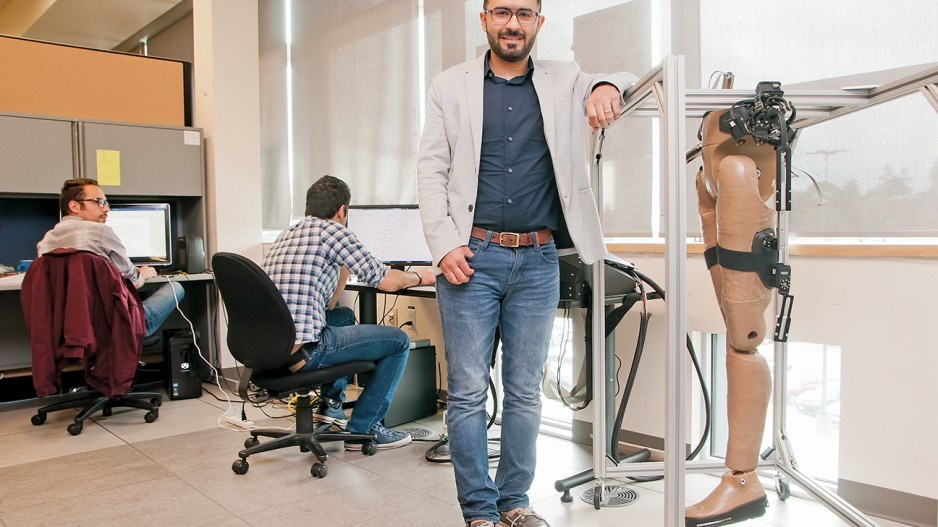“Canada is a place of opportunities for me,” said scientist and entrepreneur Soheil Sadeqi. “It literally gave me everything that I wanted, things that I could never imagine. What Canada gave me was they believed in me.”
And, since coming to Canada, the owner of Human in Motion Robotics Inc. has worked hard to provide new opportunities for others, by offering freedom of movement to people with disabilities who otherwise might have been wheelchair-bound for their entire lives.
In 2011, Sadeqi received his bachelor of science degree in mechanical engineering from the University of Tehran. The Iranian citizen was then accepted to Simon Fraser University (SFU), and that same year he began his master of science degree in mechatronics systems engineering. Coming to Canada to continue his education has given him opportunities he could have only dreamed of back home, he said.
Sadeqi recently completed his PhD, successfully defending his thesis, titled Design of a Hybrid Spherical Manipulator for Lower Limb Exoskeleton Applications. Perhaps the most crucial section of the 175-page thesis is Chapter 7, in which he lays out a design for the guidance of spherical joints, most notably hips, in powered exoskeletons – wearable machines that have a range of medical, military and civilian applications.
The exoskeletons on the market have limited mobility when it comes to movements such as walking, Sadeqi said.
Sadeqi’s supervising professors saw so much promise in his proposed solution to the problem that they helped him get an international patent filed through the Patent Cooperation Treaty and launch his startup company. The business was one of a number of enterprises launched through SFU’s Coast Capital Savings Venture Connection program.
“It’s all around the matter of coming up with the mechanics that could generate three degrees of freedom on the hip joint,” he said. “We presented for two years at the BC Tech Summit, and it gained a lot of attention. There were a lot of wheelchair users that were interested in this technology, and it gave us a lot of positive feedback.”
Human in Motion co-founder Siamak Arzanpour said his company’s exoskeleton, called Exomotion, allows for a full range of motion when users are walking, maintaining their balance, turning, walking uphill or downhill and up or down stairs.
The idea behind Exomotion is to offer a lower-body exoskeleton that can partially support the user’s weight and provide controlled guidance of leg movements, thereby allowing the wearer to stand and walk. There are multiple secondary benefits to exoskeletons, including their advantages over wheelchairs in allowing an active life, making users less susceptible to common complications associated with immobility such as pneumonia, blood clots, pressure sores and lowered self-esteem.
Arzanpour noted the market size for medical, commercial and industrial exoskeletons is estimated at around $225 million and is expected to grow to $3.37 billion by 2021.
Next up for Sadeqi, who has been living in Canada for six years and is working towards full citizenship, is building a realistic prototype. He said he’s excited to work in a field that, in fictional form, has helped sell a lot of movie tickets and comic books.
“When you’re talking about exoskeletons, the very first thing that comes into people’s minds is the Iron Man movies, that is fiction,” he said. In real life, he added, the overall goal is to help improve the quality of life for people confined to a wheelchair.
“When you speak with people with disabilities they are kind of fed up with the wheelchairs and not being able to do normal tasks and not having confidence,” he said. “The aim is forgetting about the wheelchair and getting towards a better assistant device for these users.”
Sarah Lubik, SFU’s director of entrepreneurship, said the idea behind Coast Capital Savings Venture Connection, which started in 2008 and has involved more than 6,000 participants and 500 student teams, is to get ideas such as Sadeqi’s from the classroom into the business world.




